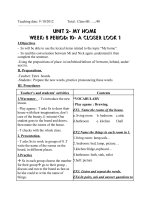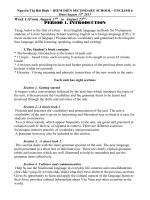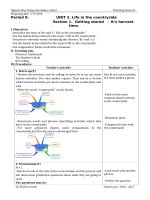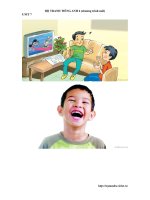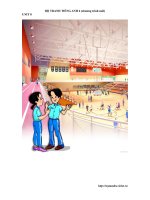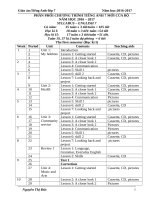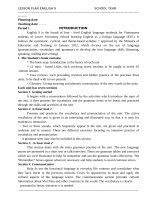- Trang chủ >>
- Sư phạm >>
- Quản lý giáo dục
giao an anh 6 thi diem unit 123
Bạn đang xem bản rút gọn của tài liệu. Xem và tải ngay bản đầy đủ của tài liệu tại đây (168.61 KB, 13 trang )
<span class='text_page_counter'>(1)</span>Period 17. Date of planning : 15 / 10 / 2012 Date of teaching : 16 / 10 / 2012 Unit 3 MY FRIEND Lesson 2: A CLOSER LOOK 1 A. OBJECTIVES: By the end of the lesson, Ss can: - use vocabulary and structures about body parts, appearances and personality. - learn plural nouns. - pronounce 2 sounds: /b/ and /p/ . C. AIDS: Posters , pictures, a cassette D. PROCEDURE: I. Warm up: Sing a song: Knees and Toes II. New lesson: 1. Vocabulary: * Activity 1: - T asks Ss to read some words about appearances, body parts. - Face/ head / eye / ear / lips / mouth / tooth / nose/cheek - Neck / Shoulders / - Arm / Hand / Finger / leg / foot / knee / elbow - Animal: Fur( lông thú )/ Tail - Some adjectives: long # short, big # small, round # long, black # blonde, curly # straight, chubby( mập mạp) Ss match the words they know. Ss listen, check and repeat the words. T asks Ss to point out the plural nouns: Learn: Watch out! PLURAL NOUNS: Noun + s / es Irregular nouns: teeth, feet… T checks Ss’comprehension by asking to respond to imperative sentences. Eg: “ Touch your head.” * Activity 2: Creat word webs: - T explains that some words go together. Eg: long / short hair, round face…… - T asks Ss to write vocabulary with correct adjectives. - Feedback: 5Ss write on the board. - T corrects their answers: + long / short: legs, arms, tail, hair + big / small: head, hands, ears, feet, eyes, nose + round / long: face + black / blonde / curry / straight: hair, fur + chubby: face, cheeks * Grammar: Have for descriptions T reviews descriptions: Structure: ( + ) S + have / has + adjective + noun ( - ) S + don’t / doesn’t + have + …………….. ( ? ) Do / Does + S + have +…………………? Example: They have long black hair. Does she have a round face? Ss look at their friends and put sentences to describe appearances..
<span class='text_page_counter'>(2)</span> * Activity 6: Ss look at the cover page of 4Teen magazine Ss make the sentences individually. Ss discuss their answers with their partner. Key: 1/ Does the girl have short hair? _ No, she doesn’t. 2/ Does Harry Potter have big eyes? 3/ The dog has a long tail. 4/ And you, do you have a round face? _ Yes, I do. / No, I don’t. * Activity 7: - Ss look at 3 pictures. - T introduces: Phuc, Duong and Mai are talking about best friends. - T uses questions to elicit vocabulary about the pictures. - Ss predict the content of the recording. - Ss listen to the tape and match the pictures to the people. - Feedback: Ss answer - Answers: a. Duong b. Mai c. Phuc 2. Pronunciation: / b / and / p / * Activity 3: - T asks some Ss to read out the words first , then plays the recording for them to listen and repeat the words. - T explains the difference of 2 sounds: - Ss practice 2 sounds, finding other words: book, pen, … * Activity 4: - T asks Ss to put the word in the correct columns while they listen. - Ss compare their answers in pairs before T checks their answers with the whole class KEY: 1. play 2.bank 3. ponytail 4. brown 5. picnic 6. pretty * Activity 5: - T asks Ss to listen to the recording carefully. - Ss practice the chant, notice the rhythm. III. Homework: Learn the new words. Do exercise 8. Practice 2 sounds: / b / and / p /. Remark:. Period 18. Date of planning : 16 / 10 / 2012 Date of teaching : 17 / 10 / 2012 Unit 3 MY FRIENDS Lesson 3: A CLOSER LOOK 2 A. OBJECTIVES: By the end of the lesson, Ss can: use the present continuous to talk about Future plans and arrangements..
<span class='text_page_counter'>(3)</span> C. AIDS: Posters , pictures, a cassette D. PROCEDURE: I. Warm up: Play the alphabet game o T calls each letter of the alphabet: a / t / h / p. o Ss try to recall a verb beginning with each letter, eg: A: act, ask… II. New lesson: 1. Presentation: * Activity 1 - T asks Ss to recall what happened in the conversation in Getting started. - Ss listen to part of the conversation again. - T asks Ss to focus on the verbs and circle them. - Answers: I’m visiting my grandma and grandpa. We’re working on our school project. - T uses the grammar box to explain: The present continuous for future: BE + V-ING S + am / is / are + ( not ) + V-ing…... * Some V-ing describe actions happening now, and some describe plans for future. Example: I’m not coming tonight. I’m busy. Notice: - contextual clues, such as use of adverbs of time: tomorrow, tonight… - some verbs lose their final “e ‘ when –ing is added: riding, talking… 2. Practice: * Activity 2: - Ss fill in the table with sentences from the conversation. - Ss feedback with their reasons for their choices. Actions now They’re coming over.. Plans for future This evening, we’re working on our school project. I’m going to the judo club with my brother. I’m visiting my grandma and grandpa.. * Activity 3: - T explains the exercise: Mai’s plans for next week, using the present continuous for future. - T asks Ss to complete the sentences individually. - Key: 1. is talking 2. isn’t going 3.is visiting 4. is having * Activity 4: - T asks Ss to read the sentences carefully. - Ss write N for actions happening now, and F for future plans. - Feedback: Ss read their answers. - T explains and corrects: 1.N 2.F 3. N 4. F 5. F 6. N 3. Production: * Activity 5: Game: Would you like to come to my party? Ss draw the table from Monday to Sunday.
<span class='text_page_counter'>(4)</span> Ss write activities next to each- they should add 3 activities listed in 5. Example: Nhung’s week Mon Tue Wed Thu Fri Sat Sunday swimming project party Ss practice the model conversation with the class. Ss go around the class and invite friends to go to your party on the day you have decided. How many people can come to your party? Ss tell the class about their plans, eg: On Tuesday, I’m going swimming with my friends. III. Homework: - Practice using the present continuous for future. - Prepare: Communication Remark:. Period 19. Date of planning : 21 / 10 / 2012 Date of teaching : 22 / 10 / 2012 Unit 3 MY FRIENDS Lesson 4: COMMUNICATION A. OBJECTIVES: By the end of the lesson, Ss can read for specific and general information in texts from 4Teen magazine and find the star sign about their friends’ personalities. C. AIDS: Posters , pictures D. PROCEDURE: I. Warm up: Survey Ss ask and answer about their birthdays. - When’s your birthday? _ It’s on……………...
<span class='text_page_counter'>(5)</span> II. New lesson: 1. Extra Vocabulary: T introduces the new words . - choir (n): hợp ca - firework competition (n): pháo hoa - greyhound racing (n): cuộc đua chó săn - field trip: chuyến đi - volunteer (n): tình nguyên viên - independent ( adj.): độc lập - curious (adj.): tò mò - responsible (adj.): chịu trách nhiệm - freedom-loving - reliable (adj.): đáng tin cậy 2. Read the passage from 4Teen magazines: - T shows the pictures of the 5 students in the magazine. - Ss look at the pictures and discuss with their friends ( Work in groups of 4/5 ).. Name ADIA VINH JOHN TOM NOKIRO. + where they are from + what their names might be + what they might like to do + ……………………………….. - Feedback 1: Ss talk about their predictions. - Ss read this page from 4Teen magazines and complete the table: - Ss ask and answer the questions: What is he / she doing at the weekend? - Feedback 2: Country Birthda On Saturday On Sunday y Yobe, Nigeria 15/5 helping her singing at her parents village’s choir club Da nang, Viet nam 7/12 going to his E going to Han river club Cambridge, 26/2 doing the to see the greyhound England gardening racing New York, US 19/1 visiting a fire going to the movie station Sakai, Japan 21/8 going to class… traveling to Shitennoji Temple. 3. Find the star sign of each friend to find out about their personality: Ss look at the poster of the star sign: Ss find the star sign of the 5 friends in 4Teen. Ss look at the adjectives of personalities in the star signs and compare them with what they read about the 5 friends in 1..
<span class='text_page_counter'>(6)</span> 4. 5. -. Look for your star sign Ss review the star sign descriptions for their own signs. Ss can tick adjectives they agree with, and cross ones the disagree with. Ss share their thoughts with a partner. Think about your friends’ personalities: Ss play a line-up game. Ss have to arrange themselves in order of birthday. Ss work in pairs to read out their partner’s star sign. III. Homework: Practice speaking about their birthday and their personality. Prepare Skills 1.. Period 20. Date of planning : 22 / 10 / 2012 Date of teaching : 23 / 10 / 2012 Unit 3 MY FRIENDS Lesson 5: SKILLS 1 A. OBJECTIVES: By the end of the lesson, Ss can: read for specific and general information in texts including advertisements and e-mails.. speak making their own English camp schedule..
<span class='text_page_counter'>(7)</span> C. AIDS: Posters , pictures D. PROCEDURE: I. Warm up: Arrange the words into 2 features: title, format, short texts, contact details, greetings, endings, eye-catching ( bắt mắt ) a/ The features of advertisement: title, short texts, eye-catching, contact details b/ The features of e-mails: format ( định dạng ), greetings, endings II. Reading: * Activity 1: Choose the best answers: T tells Ss this advertisement is about the Superb Summer Camp. T asks Ss to look at it for 2 minutes and try to remember as much as they can. T asks the class to cover the page and tell T what they remember. T elicits answers by asking: - The camp is for children of what age? - What did you see in the pictures? - What can you do at the camp? - Where will the camp be? - When does it happen? - T goes through the contents of the advertisement with the class. KEY: 1.b 2.c 3. a * Activity 2: Answer the questions: - T tells Ss the e-mail is written by a boy at the camp. - Ss discuss how he might feel when he’s spent away from home. - Feedback 1: Ss guess the answers. - T asks Ss to open their books and read quickly to check their predictions. - T sets 2 minutes limit to ensure Ss read quickly for information. KEY: 1. An e-mail 2. A stay at Superb Summer Camp 3. Yes, he is. * Activity 3: True or False? T asks Ss to read the sentences. T sets 5 minutes limit for Ss to reread the text and answer T or F. Ss work individually, then compare the answers with their partners. Key: 1/ F ( He’s writing to his parents. ) 2/ F ( He has 3.) 3/ T 4/ F ( He hopes it isn’t too scary.) 5/ F ( They’re having a campfire and telling stories.) 6/ F ( They’re visiting a milk farm.) 7/ F ( They speak English only.) III. Speaking: * Activity 4: Make your own English camp schedule - T asks Ss to complete the table ( Work individually ). Morning Afternoon Days Day one Play games Go swimming Day two Day three - Feedback: Ss report their camp schedules ( 3Ss ). * Activity 5: Tell your partners about your own English camp schedule..
<span class='text_page_counter'>(8)</span> - T goes back to the advertisement and elaborate the activities listed with Ss. - T brainstorms ideas onto the board. - T pairs Ss ands asks them to use the ideas they brainstormed to fill in their own schedule. - T can ask Ss to sit back and back. - Ss have 3 minutes to speak each other. - Ss can report to the class about their partner’s schedule. - T remarks and gives marks. IV. Homework: - Practice reading the advertisements and e-mails. - Practice speaking about the English camp schedule.. Period 21. Date of planning : 23 / 10 / 2012 Date of teaching : 24 / 10 / 2012 Unit 3 MY FRIENDS Lesson 6: SKILLS 2 A. OBJECTIVES: By the end of the lesson, Ss can: listen for specific ideas. write an entry for a magazine using notes. B. AIMS:.
<span class='text_page_counter'>(9)</span> - Help Ss - Help Ss C. AIDS: Posters , pictures D. PROCEDURE: I. Listening: 1. Vocabulary: T introduces the new words - hiking (n): đi bộ đường dài - Skiing (n): trượt tuyết - (to) take part in: tham gia - competition (n): cuộc thi - an art workshop: hội thảo nghệ thuật - traditional game: trò chơi dân gian - a public speaking class: một lớp học nói trước công chúng 2. Activity 1: T asks Ss what they see in the photos first. T runs through all the words in the box. T asks Ss to match the words with the correct pictures. Ss listen to the recording to check and practice reading the words. Key: Pictures words A Hiking B Talking part in a cooking competition C Skiing D Visiting a milk farm E Taking part in an art workshop F Riding a bicycle G Taking a public speaking class H Playing beach volleyball J Playing traditional games 3. Activity 2:Which activities may happen at the Superb Summer Camp? T asks Ss to refer to the contents of the advertisement. T gives Ss 3 minutes to decide which activities are more likely to happen at the camp and which are not. T asks Ss to explain why they think so. Key: Activities that may happen at the Superb Summer Camp: a,b,d,e,f,g,j Activities that may not happen at the Superb Summer Camp: c,h ( because the camp is in Ba Vi Mountains ) 4. Activity 3:Listen to Mr. Lee, talking on the phone with Phuc’s parents - T has Ss brainstorm the things that Mr Lee plans for camp. - Ss reread the advertisement and refer to the list in 1. -Ss listen to the recording twice and fill in the table. - Ss share their answers before playing the recording the final time. - Answer: Morning Afternoon Day two Doing a treasure hunt Visiting a milk farm and taking part in public speaking class Day three Talking part in the “ Having a good party Kids Cook” contest.
<span class='text_page_counter'>(10)</span> II. Writing: Study Skills T explains 3 letters: R ( research ), D ( draft ) and C ( check). T introduces the rubric: Write a magazine entry Ss write about their friends and then write about their plans. For Research, show some pictures T would like to use, then brainstorm vocabulary for introducing yourself, Describing friends and plans. For Draft encourage Ss to extend the brainstormed notes into full sentences. For Check, focus on what improvements can be made. Consider punctuation, structural elements such as paragraphs, titles and layout, etc. III. Homework: - Learn the new words by heart and Study skills. - Prepare Looking back and Project.. Period 22. Date of planning : 23 / 10 / 2012 Date of teaching : 24 / 10 / 2012 Unit 3 MY FRIENDS Lesson 7: LOOKING BACK & PROJECT A. OBJECTIVES: By the end of the lesson, Ss can: review vocabulary about body parts and appearance personality . use the present continuous for future. make a class yearbook. C. AIDS: Posters , pictures D. PROCEDURE: I Vocabulary: 1. Activity 1: Write the correct words on the faces - boring (adj): hơi buồn - funny (adj): buồn cười, vui vẻ - confident (adj): tự tin - hard-working (adj): siêng năng - talkative (adj): hay nói chuyện - sporty ( adj): vui chơi - shy (adj): nhút nhát, rụt rè - patient (adj): kiên nhẫn Ss draw 2 faces and write the corect words. Ss can check their answers before discussing the answers . Ss can add more words to the faces. 1. Activity 2: Make your own Haiku.
<span class='text_page_counter'>(11)</span> - T explains: Haiku is a traditional form of Japanese poetry. There are 3 lines in a Haiku: the first and the last lines have 5 syllables and the middle line has 7 syllables. - Ss read the Haiku in the textbook. - T asks Ss to create their own Haiku. - Feedback: Ss work in groups of 4 to exchange their poems and Ss guess which poem describes which person. II. Grammar: 1. Activity 3: Who’s who? Ss work in groups of 4 to choose a member of group and write a short description of him /her. Ss see the example and take part in this game. 2. Activity 4: Complete the dialogue - T elicits the language being practiced in this activity: the present continuous for future. - T asks Ss to complete the conversation individually. - Ss can share answers with their partners. - Key: A: What are you doing tomorrow? B: I’m meeting some friends. We are going ……. A: …I’m playing…. B: I’m watching…….. III. Communication: Activity 5: - T divides Ss into pairs of As and Bs. - T reminds Ss to only look at their own schedule. - Ss complete the communication activity. - As and Bs can share what they ‘ve learntabout their partners’ schedule. - Feedback: Ss practice asking and talking about future plans. IV. Project: MY CLASS YEARBOOK T shows Ss some examples of yearbooks and explains what a yearbook is and why Ss like to make them. Ss discuss the appearance and the descriptions of their examples. Ss discuss how to make their yearbook pages interesting. *Homework: - Learn the new words. - Talk about your plans, using the present continuous. - Make a class yearbook. *Remark:.
<span class='text_page_counter'>(12)</span> Monday, October 22nd ,2012 . Period 23. Date of planning : 30 / 10 / 2012 Date of teaching : 31 / 10 / 2012 REVIEW 1 A. OBJECTIVES: By the end of the lesson, Ss can: Revise the language Ss have studied include: pronunciation, vocabulary and grammar C. AIDS: Posters , pictures D. PROCEDURE: I Pronuciation: - T explains the rules + /Z/ Final -S is pronounced /Z/ after voiced sounds (b,d,g,h.m.l. . ) and any vowel sounds . EX : beds . dogs, cans, rooms + /S/ Final -S is pronounced /S/ after voiceless sounds (t,p,k, f, ) EX: cats. lamps , books, months + /IZ/ Final -ES is pronounced /IZ/ after S, Z, ∫ , t∫, dz,ch, EX: buses , houses , watches , pages - T asks Ss to give more examples 1. Elicit the rules of pronouncing the – s/es if needed. Ss do this exercise individually then share their answers with a partner before giving T the answers. Write the correct answers on the board. Key: 1.D 2. C 3. C 4. A 5. B 2. T divides the classes into two teams A and B. Ask Ss to go to board and write. Ss do this in pairs. The pair that finds the most words will go to the board and write the answers. Other pairs may want to add more words. Write other on the board. /b/ /p/ book, bag, bed,…. pen, pencil, picture, poster,… II. Vocabulary 3. Ss do this individually and then share their answers with a partner. One St may write their answers on the board. Check Ss’ answers. Key: 1. English 2. homework 3. lunch 4. sports 5. badminton 6. physics 7. lesson 8. judo Play: sports, badminton Have: lunch, a lesson Do: homework, judo Study: English, physics 4. Do the crossword puzzle: This can be done a small competition. Otherwise, Ss do this in pairs. Check Ss’ answers. Key: Across: 1. wordrobe 3. livingroom 5. apartment 6. poster Down: 2. dining room 4. hall 5. Play the game: guessing game:.
<span class='text_page_counter'>(13)</span> Ss work in groups of 4 to choose a member of group and write a short description of him /her. Ss see the example and take part in this game. - Ask Ss to close their books. - T asks Model sentence: T: What is she/he like? He/She doesn’t say much in class. S: He/ She is a quiet student Key: 2. shy 3. hard- working 4. patient 5. sporty III. Grammar: 6. - T devides the class into two teams A and B - Ask Ss to go to board and write the form of the present simple and the present continuous. - Call one St to do the exercise on the board. Check Ss’ answers. Ask them for explanation if necessary. Key: 1. is raining 2. do you have 3. am not going out; am doing 4. likes; is sleeping 5. is 7. Ask Ss to read the text carefully and pay attention to the hints. Ss do this individually and compare their answers with a partner. Check Ss’ answers and ask them to explain the negative forms in their answers. Key: 1.is 2. isn’t 3. doesn’t have 4. is 5. has 6. are 7. is 8. is 8. Ask Ss to prepare their painting and T reads. - Ss draw on the posters after T checks what they have drawn. - Give one or two to hang in front of the class. V.Everyday English: 9. Play the game: Mapped Dialogue Mi. An. Can I speak…………………………? Yes. An, are you ………………..….? Would you like……………….……..?. ……………..Mi? Yes, ………………. Yes, ……………………….. That sounds great. I’ll…………………… Alright. See……………… *Homework: - Do the Test yourself part 1,2,3,4 ( page 22,23,24) - Prepare Skills Reading, Speaking, Listening, Writing. *Remark:.
<span class='text_page_counter'>(14)</span>
